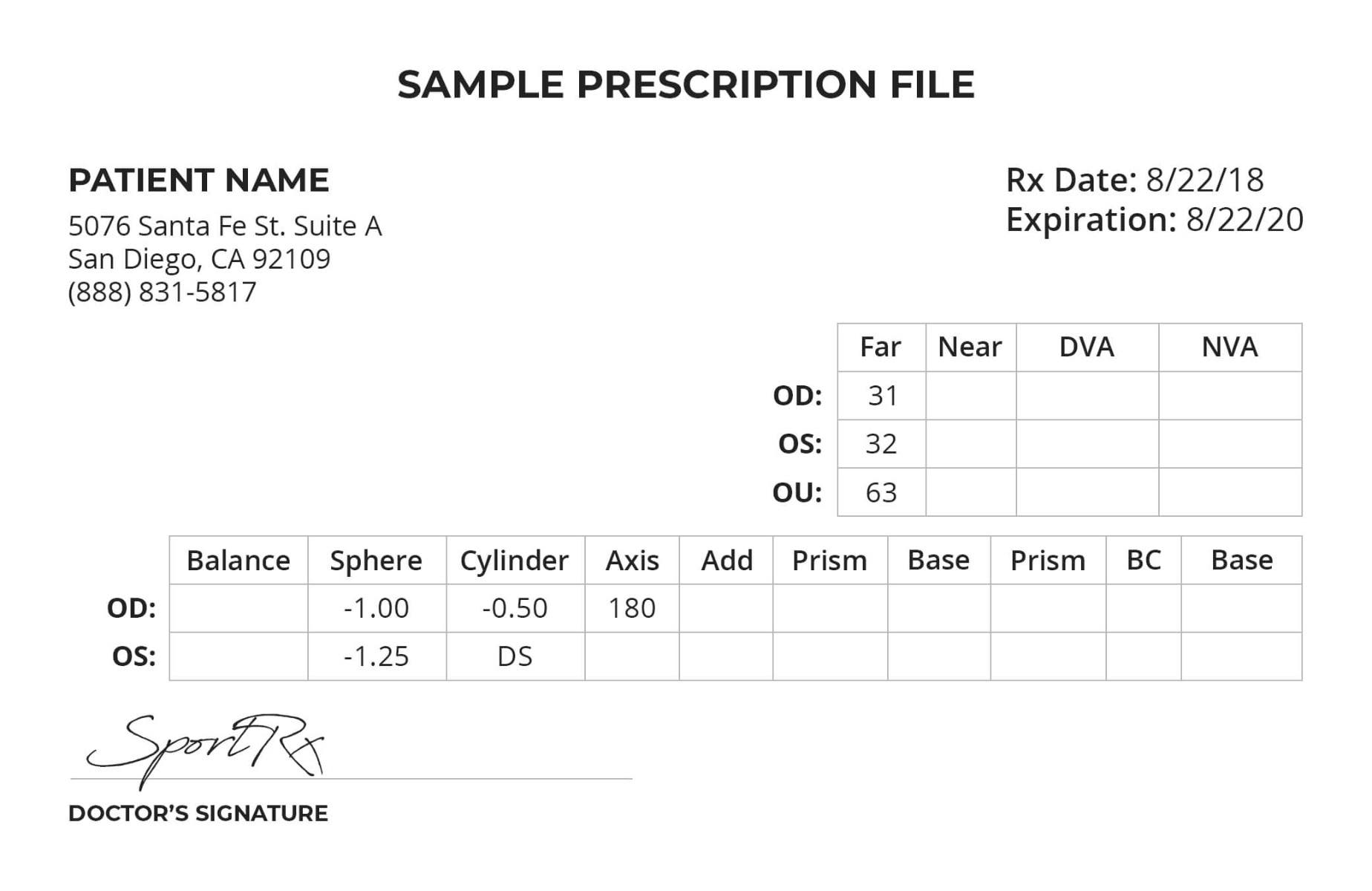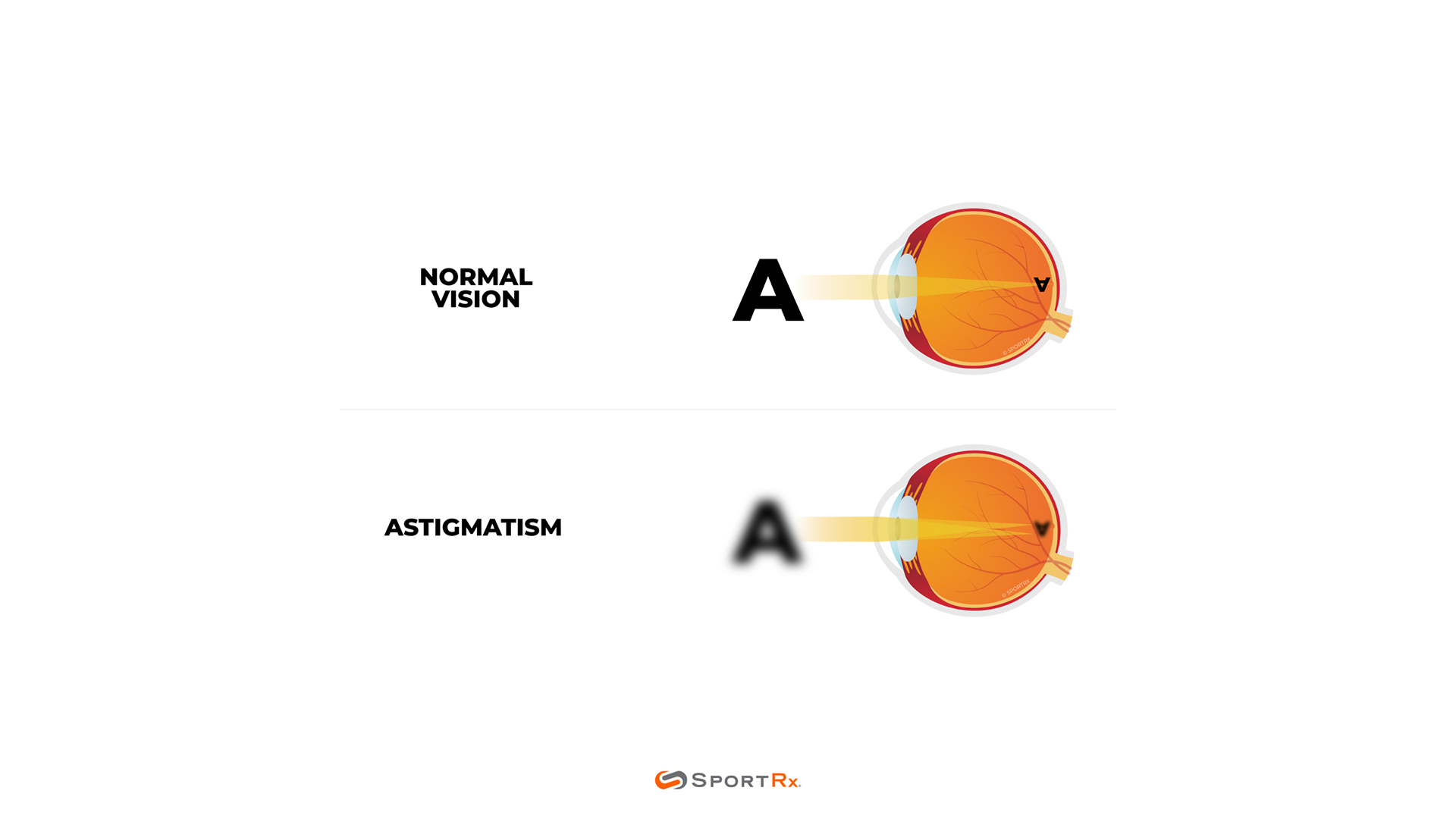Ever wondered what all those little numbers and symbols on your eye prescription mean? It's one of the questions we get asked the most, so it's high time we answered. In SportRx's new video series, Eyeglass Tyler explains the different parts that make up a prescription from your doctor. Join us so you can better understand how to read your prescription!
How to Read Your Prescription
Part 1: How to Read Your Prescription
Part 2: OD and OS
Part 3: What is SPH?
Part 4: What is CYL?
Part 5: What is AXIS?
Part 6: What is ADD?
Part 7: What is PL and DS?
Part 8: What is PD?
Part 9: What does Balance Mean?
Part 10: What is Prism?
Part 11: What is VA?
Part 12: What does Base Curve Mean?
Part 13: What does DIA Mean?
Prescription Glasses at SportRx
Part 1: How to Read Your Prescription
Before we go in-depth onto each part, Tyler provides a basic overview of all the different components of a glasses prescription.
Elements of a Glasses Prescription

- OD & OS: Right eye and left eye, respectively
- Sphere & Cylinder: Usually shortened to SPH and CYL
- Axis & Add: Used for cylinder and reading correction, respectively
- PL or Plano: Refers to zero correction in that particular row or column. You also may see "DS" under the CYL column, another way to refer to no correction.
- PD: Pupil distance
- Balance: Right and left eyes have the same prescription
- Prism: Refers to how much prism correction there is
- Base or H & V or Hz & Vt: Mean "horizontal" and "vertical," respectively, and tell you in which direction the prism is to be faced.
- VA: Visual acuity; you may also see DVA and NVA which stand for Distance Vision Acuity and Near Vision Acuity, respectively
- BC & DIA: Short for "Base Curve" and "Diameter," respectively. You'll see these on contact lens prescriptions.
These are all the basic elements that may appear on a glasses prescription, but for more details on how to read your prescription, keep going!
Part 2: OD and OS
As mentioned above, OD refers to the right eye and OS refers to the left eye. These are both Latin abbreviations, with OD short for "oculus dextrus" and OS meaning "oculus sinister." You may also see OU, which is short for "oculus uterque" and refers to both eyes. This is usually found in the PD section.
Part 3: What is SPH?
SPH is short for "Sphere" and refers to a corrective power that the whole eye needs, so it's the same across the lens.
This column may show numbers with a + or - next to them. These refer to the type of correction, with + correcting for hyperopia (farsightedness) and - correcting for myopia (nearsightedness). As these numbers get higher, the prescription gets stronger. Something higher than a -3 or +2 is considered a stronger prescription.
The strength of your prescription matters when you're picking out the type of frame you want, since a higher prescription means your selection is a little more limited.
If you only have correction in the SPH column, your prescription lenses will have the same strength, or correction, everywhere in the lens. Tyler compares a SPH correction to a basketball, which has the same dimensions all around.
In this section of the prescription, you may also see PL, which stands for "plano" and means there is no correction.
Part 4: What is CYL?
Cylinder, or CYL, refers to a type of correction your eye needs in a certain direction, or axis. This correction builds off the SPH correction we discussed above and is only present in a specific axis of the lens.
In short, CYL means you have an astigmatism. Astigmatism is a very common condition and simply means your eye isn't perfectly round. It doesn't fall under either nearsightedness or farsightedness, though it can make your vision appear blurry.

A CYL correction is easy to correct for and can be written as either a + or - depending on who wrote your prescription. It being positive or negative doesn't make a difference; the number itself is more important. As with the SPH correction, a higher CYL number means a stronger astigmatism. Over a 2 is getting into the strong range and can limit your frame options when shopping for glasses.
According to Tyler, most labs can handle up to a 3 in CYL correction but not much beyond that. However, there are specialty labs which can. Naturally, our SportRx lab is one of those.
Part 5: What is AXIS?
The axis on your prescription indicates where your CYL correction goes. Tyler notes that there isn't really such a thing as a "strong" axis and, unlike other parts of your prescription, the axis won't change or limit which frames you choose.
Part 6: What is ADD?
"ADD" is used for the amount of magnification you need for your reading area. Similar to a CYL correction, it builds off of your existing prescription but is used if you're shopping for bifocals, trifocals, or progressive lenses. An intermediate correction can also be inferred from the add number.
Using your add number, your doctor determines what you need to be able to see something clearly about 12 inches from your face, a normal reading distance. If you pick a stronger correction, you'll have to hold the object closer to your face, and if you pick a weaker one, you'll have to hold it farther from your face.
If you see PAL in the add section, that stands for "Progressive Addition Lens" and is another way to refer to progressive lenses.
Part 7: What is PL and DS?
Plano, or "PL," simply means that no prescription correction is needed in a certain part. Tyler notes that thinking of this value as a 0 can be helpful, though doctors tend to write PL instead.
You may also hear the phrase "plano lenses," which refers to non-prescription lenses and can be found in any off-the-shelf pair of sunglasses or eyeglasses.
DS is short for "Diopter Sphere" and should only be seen in your CYL column. It means there is no CYL correction needed, or in other words, no astigmatism correction.
Part 8: What is PD?
PD is the abbreviation for "pupil distance." It's the distance between your pupils (binocular PD), or the distance from each pupil to the center of your nose bridge (monocular PD), written in millimeters.
If you see "Dist" on your prescription, that's short for "Distance" and is the number we need. Near is a slightly different number used for reading, so you don't need to worry about it.
Your PD is a necessary measurement when you buy from SportRx because of something called the OC or ocular center. It's the point of the lens where the most light converges and therefore the clearest part of the lens. You want the OC to be as close as possible to the center of your pupil to avoid something called prismatic imbalance or unwanted prism. Take Tyler's word for it—it truly is unwanted.
It is also for this reason that you should strive for an accurate PD measurement rather than guessing it. Luckily, unlike your prescription a PD doesn't change after you stop growing, so a measurement from years ago will still be accurate.
If you don't see your PD on your prescription, we suggest calling the last place that made your glasses. It's a measurement every place needs in order to make prescription lenses. But if they don't have it, feel free to reach out. We can help!
Part 9: What does Balance Mean?
This is a simple one. Balance means you have the same prescription in both eyes, and is usually the result of one eye having no vision. Putting a prescription lens in front of an eye without vision is primarily for cosmetic purposes and making your eyes appear the same size. A + prescription makes your eyes look bigger, while a - prescription makes them look smaller. As the prescription gets stronger, the size difference is more noticeable.
Another reason for both lenses having the same prescription has to do with lens thickness and weight. Both lenses will weigh the same and make your glasses fit more comfortably on your face.
Part 10: What is Prism?
Prism is a trickier topic for opticians like Tyler, so we want to explain it as simply as possible. "Prism" corrects for blurred vision not caused by a refractive error, such as double vision. It allows you to use both of your eyes together by bending light to move the image and pulling your eye in the right direction.
On your prescription, you may see "prism" and "base," or "Hz" or "Vt." There's a prism amount and a prism direction, and the amount of prism needed is usually split between the 2 eyes to share the burden. Instead of putting all the "weight" (so to speak) on one eye, both eyes will share the burden and make your glasses more comfortable to wear.
If the prism is "in" or "out," both eyes will be in the same direction, while "down" and "up" will be in opposing directions, meaning one eye will be up and the other down.
Part 11: What is VA?
Like we explained at the beginning, VA is short for "Visual Acuity" and represents the sharpness or clarity of your vision. The phrase "20/20" is another way to refer to visual acuity.
While VA is a good understanding of how well you can see, it's not necessary for us at SportRx. It's unrelated to the type of correction you need or the strength of said correction and is instead based off of the Snellen chart—the standard eye chart with a giant E at the top and rows of increasingly tiny letters underneath.
20/20 means that you, a person who wears glasses, and someone who doesn't need glasses are able to read the same letter size from 20 feet away. The reason we base it off of 20 feet is because it's considered the optical infinity, and when you're looking at things 20 feet away and even further, your eye is most relaxed. Looking at something closer than 20 feet slightly strains your eye, and you also lose the ability to see things closer up as you age. That's why you get progressives!
Part 12: What does Base Curve Mean?
Base Curve, usually abbreviated as BC, is part of a contact lens prescription. It describes the curvature that fits your eyes most comfortably and usually corresponds to a specific brand. But seeing as our specialty here at SportRx is glasses, we'll also talk about what it means in the context of glasses.
Sometimes, you'll see a number under BC. This is the base curve that works best with your prescription, since stronger prescriptions tend not to work as well in more curved frames. A 6-base curve is a flatter frame than an 8-base curve, a 4-base is flatter than a 6-base, and so on. It's good to mention your BC measurement to our opticians when ordering glasses so we can help you pick out the best frame for your needs.
Part 13: What does DIA Mean?
DIA is short for "Diameter" and, like BC, is something found on contact lens prescriptions. It refers to the diameter in millimeters of the contact lens that will best suit your eye. As Tyler points out, your doctor writes a contact lens prescription for a specific brand, so as long as you stick to the prescribed brand you shouldn't have issues.
Prescription Glasses at SportRx
We've made it to the end! Hopefully this series was helpful in explaining the different components of an eye prescription so that you know how to read your own prescription. Ready to shop some glasses at SportRx? When you shop with us, you’ll find video guides and tooltips throughout the build process as you customize the perfect pair. An answer to all your questions is at your fingertips, and if you want to chat with an expert, feel free to reach out. We’ll put you in touch with one of our friendly in-house opticians who can help you build your prescription glasses or sunglasses.
Ditch risky online shopping with the See Better Guarantee. Try your glasses for 45 days. If you’re not satisfied, send them back. Get a full refund, exchange, or credit towards a better pair. And return shipping? Covered. Get your pair of prescription glasses or sunglasses at SportRx today!






thanks
Filip
Thank you for reading!
In the first, top box, what do the numbers mean for far and near? I have numbers in both columns. Does that mean nearsighted and farsighted?
Thanks!
Thank you for the question!